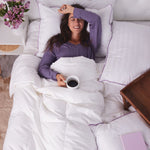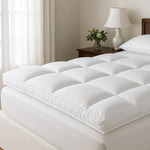You have no items in your shopping cart.

Lavender is a herb that has been used for numerous purposes over the years. It is good for your skin and hair, can be used to replace dryer sheets, makes a good air freshener and traditionally was put in drawers with clothes to keep away moths.
The use lavender is often most known for, however, is to promote restful sleep. Lavender is a natural sleep and relaxation aid that does not have strong side effects (the more powerful herb, valerian, can have some of the same side effects as sleeping pills) and is safe for use by children (although it is not recommended while breastfeeding). It has been proven to help 60% of the people who use it gain better sleep – so it is worth a try if you have sleep issues.
Lavender is easy to buy and if you have space you can also grow it yourself. It is a pretty forgiving plant and will grow well in a pot (as long as you add gravel). It is, though, a sun lover.
If you want to try lavender, how can you use it for sleep? There are several ways:
1. A sachet under the pillow. This use of lavender has years of tradition behind it, especially in England. Use dried lavender buds or flowers. You can also add other herbs that are helpful for sleep – chamomile, catnip (although not if you have cats – for obvious reasons) and maybe a little bit of rosemary. However, some people find this method a little too strong for them, especially to start with. A cheaper alternative is to put a few drops of oil on a couple of cotton balls and put them inside the pillow case.
2. Essential oil in a diffuser. Use a nebulizer or ultrasonic diffuser – they’re more efficient than heat-based ones and safer. As nebulizers can be loud, use in the time before bed and then turn off when you actually go to sleep.
3. Use a pillow mist – dilute lavender essential oil in hot water, let it cool, and then spray your pillow and the top of your sheets. The same mister can also be used as a body spray if you are the kind of person who likes a shower before bed.
4. If you like to soak in your tub before bed, use lavender bath salts to help you relax. Combined with warm water this can make for a two-fer (the temperature drop can slow your metabolism and help you doze off).
5. As a massage oil. Especially if you have a partner who is good at back rubs, but you can also apply the oil yourself to neck, shoulders, and feet. If you are prone to waking up with a headache, add a little bit to your temples. Use a commercial lavender-based massage oil or carefully make your own (lavender is safer than most essential oils but you still should be careful).
6. Buy or make a lotion or balm. Again, you can add other sleep promoting herbs to this – try plain lavender first, and consider experimenting with a few recipes until you have success. Lavender lotions will also have the wonderful side effect of improving your sleep.
Before you start using lavender make sure you are not allergic to it (it is not a common allergen, but things do happen). Again, do not use lavender essential oil if nursing, as there have been no good studies as to its safety, or for infants. However, older children can definitely benefit from the effects. Also, if you grow your own lavender, remember you can use it in cooking – it adds a delicate flavor and a relaxing effect (lavender ice cream is particularly good), in skin lotions, and just to make things smell good.
If you’re ready to improve your sleep, it’s time for a Queen Anne Pillow!
Photo Credit:

Lavender is a herb that has been used for numerous purposes over the years. It is good for your skin and hair, can be used to replace dryer sheets, makes a good air freshener and traditionally was put in drawers with clothes to keep away moths.
The use lavender is often most known for, however, is to promote restful sleep. Lavender is a natural sleep and relaxation aid that does not have strong side effects (the more powerful herb, valerian, can have some of the same side effects as sleeping pills) and is safe for use by children (although it is not recommended while breastfeeding). It has been proven to help 60% of the people who use it gain better sleep – so it is worth a try if you have sleep issues.
Lavender is easy to buy and if you have space you can also grow it yourself. It is a pretty forgiving plant and will grow well in a pot (as long as you add gravel). It is, though, a sun lover.
If you want to try lavender, how can you use it for sleep? There are several ways:
1. A sachet under the pillow. This use of lavender has years of tradition behind it, especially in England. Use dried lavender buds or flowers. You can also add other herbs that are helpful for sleep – chamomile, catnip (although not if you have cats – for obvious reasons) and maybe a little bit of rosemary. However, some people find this method a little too strong for them, especially to start with. A cheaper alternative is to put a few drops of oil on a couple of cotton balls and put them inside the pillow case.
2. Essential oil in a diffuser. Use a nebulizer or ultrasonic diffuser – they’re more efficient than heat-based ones and safer. As nebulizers can be loud, use in the time before bed and then turn off when you actually go to sleep.
3. Use a pillow mist – dilute lavender essential oil in hot water, let it cool, and then spray your pillow and the top of your sheets. The same mister can also be used as a body spray if you are the kind of person who likes a shower before bed.
4. If you like to soak in your tub before bed, use lavender bath salts to help you relax. Combined with warm water this can make for a two-fer (the temperature drop can slow your metabolism and help you doze off).
5. As a massage oil. Especially if you have a partner who is good at back rubs, but you can also apply the oil yourself to neck, shoulders, and feet. If you are prone to waking up with a headache, add a little bit to your temples. Use a commercial lavender-based massage oil or carefully make your own (lavender is safer than most essential oils but you still should be careful).
6. Buy or make a lotion or balm. Again, you can add other sleep promoting herbs to this – try plain lavender first, and consider experimenting with a few recipes until you have success. Lavender lotions will also have the wonderful side effect of improving your sleep.
Before you start using lavender make sure you are not allergic to it (it is not a common allergen, but things do happen). Again, do not use lavender essential oil if nursing, as there have been no good studies as to its safety, or for infants. However, older children can definitely benefit from the effects. Also, if you grow your own lavender, remember you can use it in cooking – it adds a delicate flavor and a relaxing effect (lavender ice cream is particularly good), in skin lotions, and just to make things smell good.
If you’re ready to improve your sleep, it’s time for a Queen Anne Pillow!
Photo Credit:








